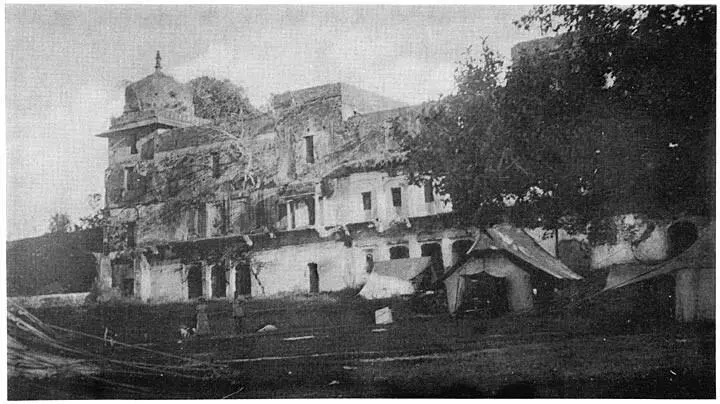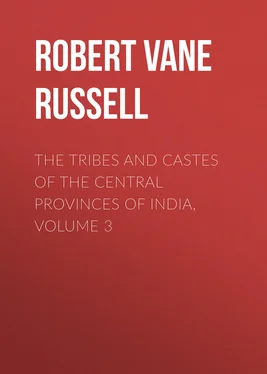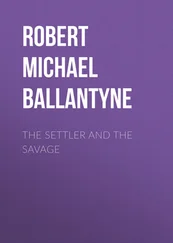Robert Vane Russell - The Tribes and Castes of the Central Provinces of India, Volume 3
Здесь есть возможность читать онлайн «Robert Vane Russell - The Tribes and Castes of the Central Provinces of India, Volume 3» — ознакомительный отрывок электронной книги совершенно бесплатно, а после прочтения отрывка купить полную версию. В некоторых случаях можно слушать аудио, скачать через торрент в формате fb2 и присутствует краткое содержание. Жанр: foreign_prose, История, foreign_edu, foreign_antique, на английском языке. Описание произведения, (предисловие) а так же отзывы посетителей доступны на портале библиотеки ЛибКат.
- Название:The Tribes and Castes of the Central Provinces of India, Volume 3
- Автор:
- Жанр:
- Год:неизвестен
- ISBN:нет данных
- Рейтинг книги:5 / 5. Голосов: 1
-
Избранное:Добавить в избранное
- Отзывы:
-
Ваша оценка:
- 100
- 1
- 2
- 3
- 4
- 5
The Tribes and Castes of the Central Provinces of India, Volume 3: краткое содержание, описание и аннотация
Предлагаем к чтению аннотацию, описание, краткое содержание или предисловие (зависит от того, что написал сам автор книги «The Tribes and Castes of the Central Provinces of India, Volume 3»). Если вы не нашли необходимую информацию о книге — напишите в комментариях, мы постараемся отыскать её.
The Tribes and Castes of the Central Provinces of India, Volume 3 — читать онлайн ознакомительный отрывок
Ниже представлен текст книги, разбитый по страницам. Система сохранения места последней прочитанной страницы, позволяет с удобством читать онлайн бесплатно книгу «The Tribes and Castes of the Central Provinces of India, Volume 3», без необходимости каждый раз заново искать на чём Вы остановились. Поставьте закладку, и сможете в любой момент перейти на страницу, на которой закончили чтение.
Интервал:
Закладка:
4. History of the Gonds
As stated in the article on Kol, it is known that Rājpūt dynasties were ruling in various parts of the Central Provinces from about the sixth to the twelfth centuries. They then disappear, and there is a blank till the fourteenth century or later, when Gond kingdoms are found established at Kherla in Betūl, at Deogarh in Chhīndwara, at Garha-Mandla, 42 42 Garha is six miles from Jubbulpore.
including the Jubbulpore country, and at Chānda, fourteen miles from Bhāndak. It seems clear, then, that the Hindu dynasties were subverted by the Gonds after the Muhammadan invasions of northern India had weakened or destroyed the central powers of the Hindus, and prevented any assistance being afforded to the outlying settlements. There is some reason to suppose that the immigration of the Gonds into the Central Provinces took place after the establishment of these Hindu kingdoms, and not before, as is commonly held. 43 43 See article on Kol.
But the point must at present be considered doubtful. There is no reason however to doubt that the Gonds came from the south through Chānda and Bastar. During the fourteenth century and afterwards the Gonds established dynasties at the places already mentioned in the Central Provinces. For two or three centuries the greater part of the Province was governed by Gond kings. Of their method of government in Narsinghpur, Sleeman said: “Under these Gond Rājas the country seems for the most part to have been distributed among feudatory chiefs, bound to attend upon the prince at his capital with a stipulated number of troops, to be employed wherever their services might be required, but to furnish little or no revenue in money. These chiefs were Gonds, and the countries they held for the support of their families and the payment of their troops and retinue little more than wild jungles. The Gonds seem not to have been at home in open country, and as from the sixteenth century a peaceable penetration of Hindu cultivators into the best lands of the Province assumed large dimensions, the Gonds gradually retired to the hill ranges on the borders of the plains.” The headquarters of each dynasty at Mandla, Garha, Kherla, Deogarh and Chānda seem to have been located in a position strengthened for defence either by a hill or a great river, and adjacent to an especially fertile plain tract, whose produce served for the maintenance of the ruler’s household and headquarters establishment. Often the site was on other sides bordered by dense forest which would afford a retreat to the occupants in case it fell to an enemy. Strong and spacious forts were built, with masonry tanks and wells inside them to provide water, but whether these buildings were solely the work of the Gonds or constructed with the assistance of Hindu or Muhammadan artificers is uncertain. But the Hindu immigrants found Gond government tolerant and beneficent. Under the easy eventless sway of these princes the rich country over which they ruled prospered, its flocks and herds increased, and the treasury filled. So far back as the fifteenth century we read in Firishta that the king of Kherla, who, if not a Gond himself, was a king of the Gonds, sumptuously entertained the Bāhmani king and made him rich offerings, among which were many diamonds, rubies and pearls. Of the Rāni Dūrgavati of Garha-Mandla, Sleeman said: “Of all the sovereigns of this dynasty she lives most in the page of history and in the grateful recollections of the people. She built the great reservoir which lies close to Jubbulpore, and is called after her Rāni Talao or Queen’s pond; and many other highly useful works were formed by her about Garha.” When the castle of Chaurāgarh was sacked by one of Akbar’s generals in 1564, the booty found, according to Firishta, comprised, independently of jewels, images of gold and silver and other valuables, no fewer than a hundred jars of gold coin and a thousand elephants. Of the Chānda rulers the Settlement officer who has recorded their history wrote that, “They left, if we forget the last few years, a well-governed and contented kingdom, adorned with admirable works of engineering skill and prosperous to a point which no aftertime has reached. They have left their mark behind them in royal tombs, lakes and palaces, but most of all in the seven miles of battlemented stone wall, too wide now for the shrunk city of Chānda within it, which stands on the very border-line between the forest and the plain, having in front the rich valley of the Wardha river, and behind and up to the city walls deep forest extending to the east.” According to local tradition the great wall of Chānda and other buildings, such as the tombs of the Gond kings and the palace at Junona, were built by immigrant Telugu masons of the Kāpu or Munurwār castes. Another excellent rule of the Gond kings was to give to any one who made a tank a grant of land free of revenue of the land lying beneath it. A large number of small irrigation tanks were constructed under this inducement in the Wainganga valley, and still remain. But the Gond states had no strength for defence, as was shown when in the eighteenth century Marātha chiefs, having acquired some knowledge of the art of war and military training by their long fighting against the Mughals, cast covetous eyes on Gondwāna. The loose tribal system, so easy in time of peace, entirely failed to knit together the strength of the people when united action was most required, and the plain country fell before the Marātha armies almost without a struggle. In the strongholds, however, of the hilly ranges which hem in every part of Gondwāna the chiefs for long continued to maintain an unequal resistance, and to revenge their own wrongs by indiscriminate rapine and slaughter. In such cases the Marātha plan was to continue pillaging and harassing the Gonds until they obtained an acknowledgment of their supremacy and the promise, at least, of an annual tribute. Under this treatment the hill Gonds soon lost every vestige of civilisation, and became the cruel, treacherous savages depicted by travellers of this period. They regularly plundered and murdered stragglers and small parties passing through the hills, while from their strongholds, built on the most inaccessible spurs of the Satpūras, they would make a dash into the rich plains of Berār and the Nerbudda valley, and after looting and killing all night, return straight across country to their jungle fortresses, guided by the light of a bonfire on some commanding peak. 44 44 Mr. Standen’s Betūl Settlement Report .
With the pacification of the country and the introduction of a strong and equable system of government by the British, these wild marauders soon settled down and became the timid and inoffensive labourers which they now are.

Palace of the Gond kings of Garha-Mandla at Rāmnagar
5. Mythica traditions. Story of Lingo
Mr. Hislop took down from a Pardhān priest a Gond myth of the creation of the world and the origin of the Gonds, and their liberation from a cave, in which they had been shut up by Siva, through the divine hero Lingo. General Cunningham said that the exact position of the cave was not known, but it would seem to have been somewhere in the Himalayas, as the name Dhawalgiri, which means a white mountain, is mentioned. The cave, according to ordinary Gond tradition, was situated in Kachikopa Lohāgarh or the Iron Valley in the Red Hill. It seems clear from the story itself that its author was desirous of connecting the Gonds with Hindu mythology, and as Siva’s heaven is in the Himalayas, the name Dhawalgiri, where he located the cave, may refer to them. It is also said that the cave was at the source of the Jumna. But in Mr. Hislop’s version the cave where all the Gonds except four were shut up is not in Kachikopa Lohāgarh, as the Gonds commonly say; but only the four Gonds who escaped wandered to this latter place and dwelt there. And the story does not show that Kachikopa Lohāgarh was on Mount Dhawalgiri or the Himalayas, where it places the cave in which the Gonds were shut up, or anywhere near them. On the contrary, it would be quite consonant with Mr. Hislop’s version if Kachikopa Lohāgarh were in the Central Provinces. It may be surmised that in the original Gond legend their ancestors really were shut up in Kachikopa Lohāgarh, but not by the god Siva. Very possibly the story began with them in the cave in the Iron Valley in the Red Hill. But the Hindu who clearly composed Mr. Hislop’s version wished to introduce the god Siva as a principal actor, and he therefore removed the site of the cave to the Himalayas. This appears probable from the story itself, in which, in its present form, Kachikopa Lohāgarh plays no real part, and only appears because it was in the original tradition and has to be retained. 45 45 The argument in this section will be followed more easily if read after the legend in the following paragraphs.
But the Gonds think that their ancestors were actually shut up in Kachikopa Lohāgarh, and one tradition puts the site at Pachmarhi, whose striking hill scenery and red soil cleft by many deep and inaccessible ravines would render it a likely place for the incident. Another version locates Kachikopa Lohāgarh at Dārekasa in Bhandāra, where there is a place known as Kachagarh or the iron fort. But Pachmarhi is perhaps the more probable, as it has some deep caves, which have always been looked upon as sacred places. The point is of some interest, because this legend of the cave being in the Himalayas is adduced as a Gond tradition that their ancestors came from the north, and hence as supporting the theory of the immigration of the Dravidians through the north-west of India. But if the view now suggested is correct, the story of the cave being in the Himalayas is not a genuine Gond tradition at all, but a Hindu interpolation. The only other ground known to the writer for asserting that the Gonds believed their ancestors to have come from the north is that they bury their dead with the feet to the north. There are other obvious Hindu accretions in the legend, as the saintly Brāhmanic character of Lingo and his overcoming the gods through fasting and self-torture, and also the fact that Siva shut up the Gonds in the cave because he was offended by their dirty habits and bad smell. But the legend still contains a considerable quantity of true Gond tradition, and though somewhat tedious, it seems necessary to give an abridgment of Mr. Hislop’s account, with reproduction of selected passages. Captain Forsyth also made a modernised poetical version, 46 46 Highlands of Central India (Chapman & Hall).
from which one extract is taken. Certain variations from another form of the legend obtained in Bastar are included.
Интервал:
Закладка:
Похожие книги на «The Tribes and Castes of the Central Provinces of India, Volume 3»
Представляем Вашему вниманию похожие книги на «The Tribes and Castes of the Central Provinces of India, Volume 3» списком для выбора. Мы отобрали схожую по названию и смыслу литературу в надежде предоставить читателям больше вариантов отыскать новые, интересные, ещё непрочитанные произведения.
Обсуждение, отзывы о книге «The Tribes and Castes of the Central Provinces of India, Volume 3» и просто собственные мнения читателей. Оставьте ваши комментарии, напишите, что Вы думаете о произведении, его смысле или главных героях. Укажите что конкретно понравилось, а что нет, и почему Вы так считаете.












